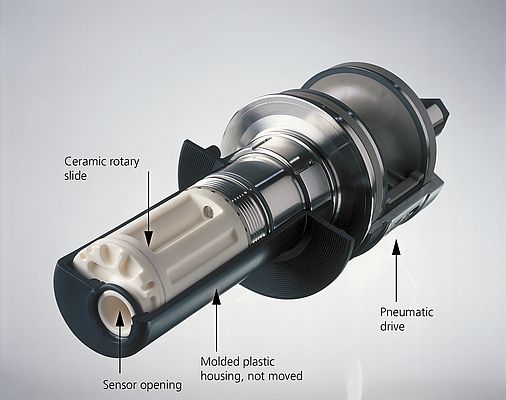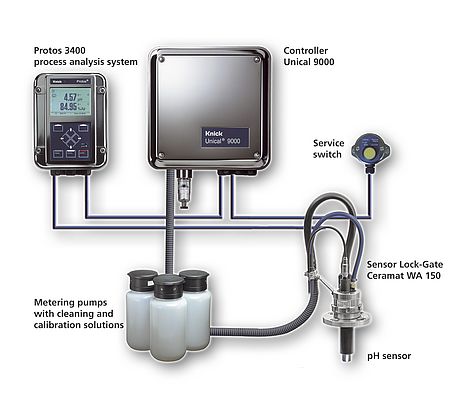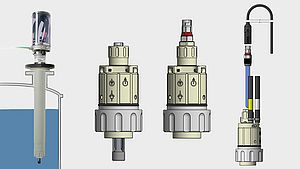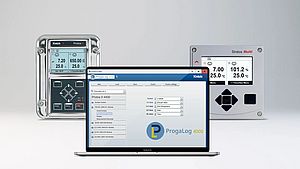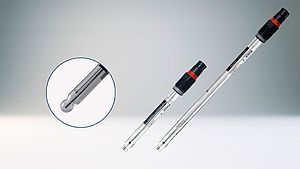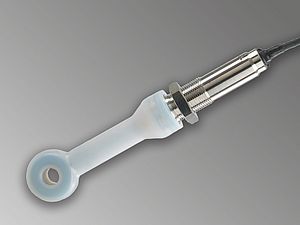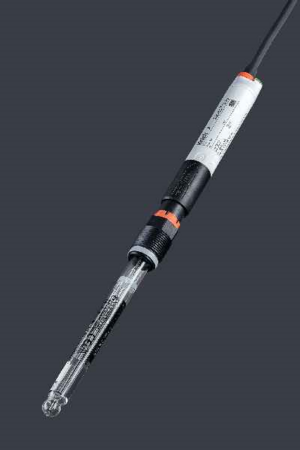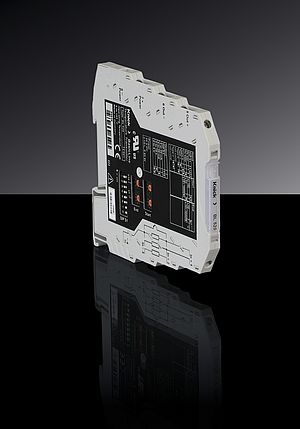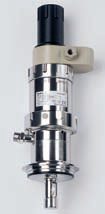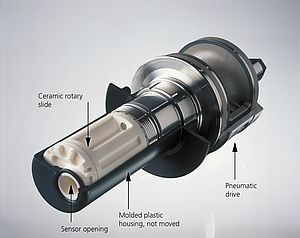At the Shell Rheinland Refinery, fractions of heavy oil are left at the end of the fuel extraction process. Shell then uses these to operate an oil-fired power station to supply the site. In the associated flue-gas desulfurization plant, the waste-water treatment is monitored at three points of measurement with average pH values between 2 and 10. The deposits occurring in this pH range place enormous stress on the points of measurement and require costly and regular maintenance. Automation previously failed due to a lack of appropriate (mechanically and chemically resistant) fittings. Metallic retractable fittings, such as ball valve fittings, corrode and the moving parts become blocked due to severe incrustation as occurs in heavily alkaline process media. Fittings made from conventional plastics usually fail due to the mechanical and thermal loads.
In addition to regular cleaning, Knick’s robust system solution for pH measurement also automates calibration as well as permitting access for maintenance while the plant is still in operation. The pH measurement and analysis system from Knick comprises the Ceramat® WA 150 retractable fitting, the Protos® 3400 analyzer and the Unical® 9000 automated cleaning and calibration system.
Process and measurement problems
Due to the outstanding separation efficiency in flue gas desulfurization plants of more than 95%, the so-called wet scrubbing process is usually used. An alkaline solution, often lime water, is used to absorb the sulfur dioxide, and is sprayed from above in the absorber tower or scrubber while the flue gas is channeled upwards in a counter flow. The reaction creates a lye from which gypsum can be extracted through precipitation and flocking. This is sometimes used in the construction industry. The remaining excess water is neutralized by adding sulfuric acid to bind it with the excess lime.
The process conditions place extreme challenges on the pH measurement points: The solids content is between 2% and 15% and the alkaline scrubbing solution encourages the formation of deposits, clogging and incrustation on the fittings. The aggressive scrubbing solution shortens the life of the electrodes. Due to the heavy build-up of deposits, the pH sensors have to be cleaned often. An automated measuring system therefore makes life easier.
Systematic solution
The Ceramat® WA 150 sensor lock-gate combined with the Unical® 9000 automatic cleaning and calibration system facilitates the complete automation of this difficult measuring task. Reliability is considerably increased and maintenance costs are minimized by the service switch with check-back of the actual probe position and the separate media routing which requires minimum buffer consumption and prevents backmixing of the media. The system is connected to the process control technology via a Profibus PA interface.
Hermetically sealed sensor lock-gate
With the aid of the Ceramat® WA 150 sensor lock-gate, the sensor is automatically cleaned and calibrated on a regular basis. Due to the aggressive process conditions, the sensor can remain in the rinsing chamber to protect and extend its life, only being briefly inserted into the process medium to carry out measurements (e. g. every minute for ten seconds). The probe is particularly easy to maintain: The pneumatic drive can be replaced on site under full process pressure, and all relevant seals and the rinsing chamber can be accessed without special tools. The Ceramat® sensor lock-gate has proved to be particularly successful in extremely difficult processes where fittings with O-ring seals fail. It comprises a practically indestructible, rotating ceramic element and a corrosion-resistant, carbon fiber reinforced, fixed PEEK plastic housing. Lapped and polished sealing surfaces guarantee high and constant tightness. Thanks to the hardness of the ceramic element, the level sealing surfaces do not wear, even in very abrasive media.
Flexible control unit
The Unical® 9000 serves as an electro-pneumatic controller for insertion and retraction of the sensor and the pumps for the buffer and cleaning solutions; the solutions are monitored and an alarm is triggered if necessary. Calibration of the sensor is fully automatic and takes place by means of preset or plant-specific program flows, considerably reducing maintenance costs as a result. The Unical® 9000 has a reliable pump system with three separate pumps for buffer, cleaning and rinsing solutions with separate media routing. This prevents contamination of the media (in particular of the buffer solutions) and thus avoids the necessary, costly purging of the lines – this guarantees both increased measuring accuracy and economic use of the media. The integrated signal contacts for noncontacting limit position control provide additional operating safety.
The Unical® controller is operated and powered via the Protos® analyzer.
Preparation and data analysis
All process data is shown on the display of the Protos® 3400 analyzer.
Protos® enables the integration of different measuring functions – three slots are available for the various measuring and add-on modules. With the aid of a SmartMedia card, up to five parameter sets can be saved. Memory cards can be used to expand the capacity of the integrated measurement recorder and the logbook almost without limit. A Profibus PA interface facilitates the digital connection to the control technology. The analyzer’s user interface, developed in accordance with NAMUR recommendations, is very clearly structured; it uses neat icons as well as plaintext menus and explanations in one of six available languages. Thanks to the graphical representation in the form of a sensor network diagram, all important sensor data such as slope, zero point, reference impedance and glass impedance can be comprehended at a glance. Protos® also facilitates the definition of individually accessible operating levels protected by passcodes. Consequently, every user only has access to the device functions relating to their duties, thereby benefiting operational and functional security.
Decision for Knick technology
The presentation of Knick’s automatic pH measuring system at a trade show prompted Shell to operate it on a test basis in parallel with its current system with permanently installed sensors. After just a few short hours, the test values differed dramatically from each other as the permanently installed sensors quickly became polluted, while the use of the Ceramat® sensor lock-gate provided reliable results. In long-term operation with conventional maintenance intervals, the sensor consumption also proved to be disproportionately higher than the savings from the cheaper installation. A competitor product with automatic lock-gate and calibration was also tested. Knick came off well here with a considerably lower consumption of rinsing solution. The conversion was carried out in 2002/03. Since then, the availability of the system has reliably been at almost 100%, in contrast to approximately 5% to 10% with the previous system.
With the Protos® 3400 modular process analysis system, the Unical® 9000 electro-pneumatic controller and the Ceramat® WA 150 sensor lock-gate, Knick has developed a complete solution characterized by maximum availability, optimal process management, minimal maintenance expenditure and low operating costs. The fully automatic pH measuring system is also recommended for other applications in the chemicals, pharmaceutical and foodstuffs industries. Its measuring accuracy and reliability during operation, resistance to contamination and suitability for problematic media all increase the process safety and open up certain applications for automation for the first time.
The statutory principles
The emission limits for air pollutants are uniformly regulated across the EU. In Germany, they are implemented by national statute, namely the Federal Immission Control Act and its implementation orders, the Regulation on Large Combustion Plants and the Technical Instructions on Air Quality. In the USA, the corresponding legislation is the Clean Air Act. Statutory provisions on the treatment of waste water – the Federal Water Act and the Waste Water Ordinance in Germany, the Clean Water Act in the USA – do not specify any limit values, referring instead to the ‘state of the art’. New plants constructed around the world tend to follow current western standards, so flue-gas and waste-water purification have a role to play in most new constructions.
pH measuring system
proves itself under adverse conditions
- by Knick Elektronische Messgeräte
- May 29, 2012
- 1051 views


